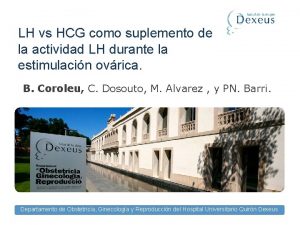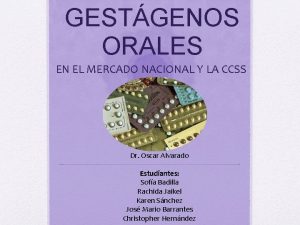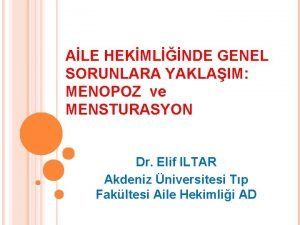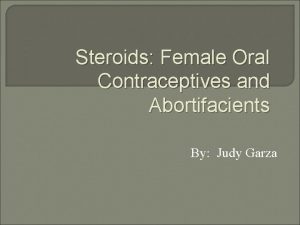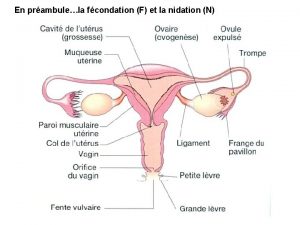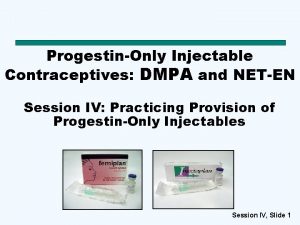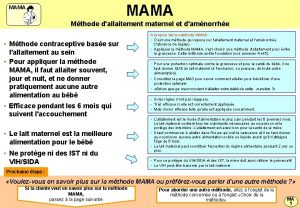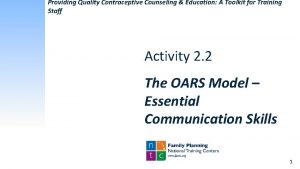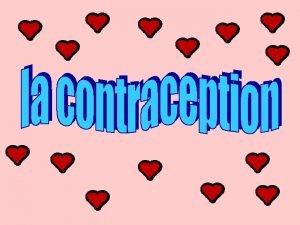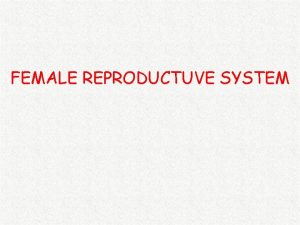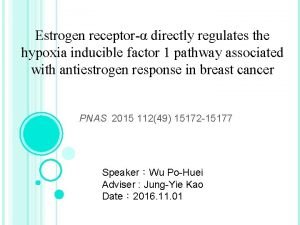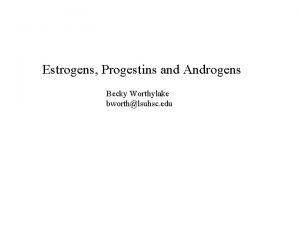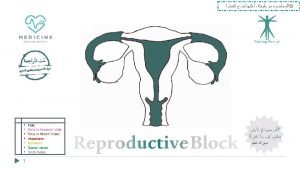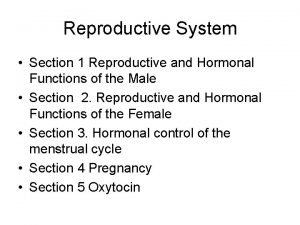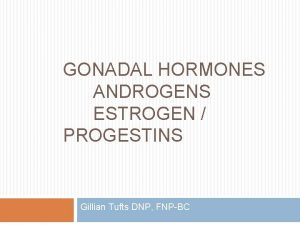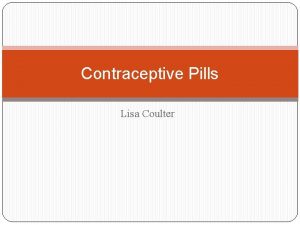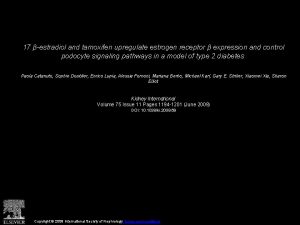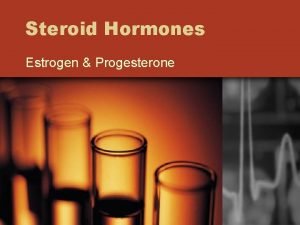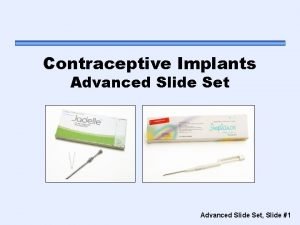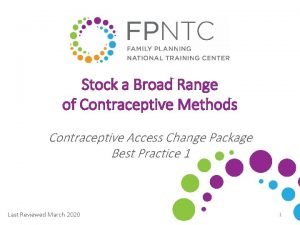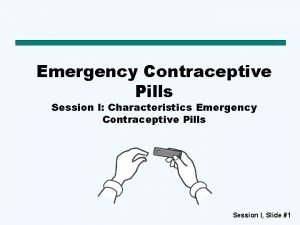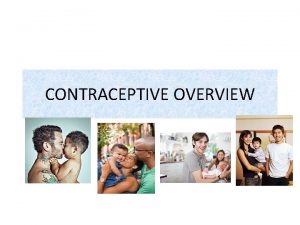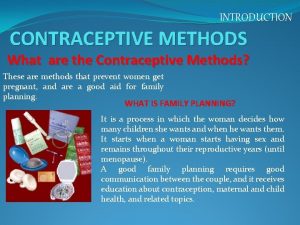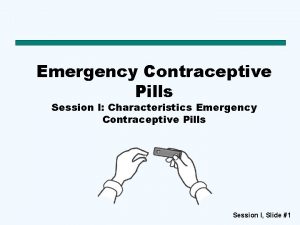Oral contraceptive Progestins Estrogen Ethinyl estradiol or mestranol














- Slides: 14


Oral contraceptive Progestins : Estrogen : Ethinyl estradiol or mestranol (a prodrug converted to ethinyl estradiol) Has systemic androgenic effect: Norethindrone , Levonorgestrel, Medroxyprogesterone acetate Has no systemic androgenic effect: Norgestimate, Desogestre, Drospirenone M. O. A Combined pills (COC) Contains estrogen & progestin (100% effective) : • • • Inhibit Ovulation by Suppressing The Release Of Gonadotrophins (FSH & LH) Increase viscosity of the cervical mucus making it so viscous → no sperm pass Inhibit IMPLANTATION by causing abnormal contraction of the fallopian tubes & uterine Monthly Pills musculature → ovum will be expelled rather than implanted. • • • For 21 days: starting on day 5, ending at day 26. This is followed by a 7 day pill free period To improve compliance: a formulation of 28 pills: ✓ The first 21 pills are of multiphasic formulation ✓ Followed by the last 7 pills are actually placebo Seasonal Pills • • Taken continuously for 84 days, break for 7 days, Cover 91 days schedule Has very low doses of both estrogens and progestins. v Benefit: ✓ It lessens menstrual periods to 4 times a year. v Disadvantages: ü ✓ Useful in those who have menstrual or menstrual disorders(prevent migrane), and in perimenopausal Higher incidence of breakthrough bleeding ü women with vasomotor symptoms(Painful & heavy spotting during early use. Interactions Adverse effects periods=menorrhagia & dysmenorrhea). • Impaired glucose tolerane(hyperglycemia) • Increase incidence of breast, vaginal & cervical cancer • Cardiovascular (major concern): o Thromboembolism , Hypertension • • Weight gain Hirsutism Masculinization (Norethindrone) Menstrual irregularities v Medications that cause contraceptive failure : • Impairing absorption: (e. g. ampicillin) • Microsomal Enzyme (CYT P 450 ) Inducers (e. g. Phenytoin , Phenobarbitone, Rifampin, ) v Medications that increase combined oral contraceptive toxicity: • Microsomal Enzyme Inhibitors: (e. g. Acetaminophen, Erythromycin). v Medications altered in clearance of combined oral contraceptive which increase their toxicity: • (e. g. Warfarin, Cyclosporine, Theophyline).

Oral contraceptive Note Contains only a progestin as norethindrone or desogestrel…. M. O. A • The main effect: increase cervical mucus, so no sperm penetration & therefore, no fertilization. Uses MINI Pills, Progestin‐Only Pills (POP) • Are alternative when oestrogen is contraindicated (e. g. : during breast feeding, hypertension, cancer, smokers over the age of 35). Post Coital Contraception (Emergency Contraception) Contraception on instantaneous demand, 2 ndry to unprotected sexual intercourse v They are used when desirability for avoiding pregnancy is obvious : • • • Unsuccessful withdrawal before ejaculation Torn, leaking condom Missed pills Exposure to teratogen e. g. Live vaccine Rape Composition Method of Administration Ethinyl estadiol 1 + 2 tablets twice with 12 hrs in Levonorgestrel 2 between* High‐dose only Ethinyl estadiol High dose only levonorgestrel Mifepristone ± Misoprostol 1 2 Timing of 1 st dose After Intercourse Reported Efficacy 0 ‐ 72 hrs 75% Twice daily for 5 days 0 ‐ 72 hrs 75 ‐ 85% Twice daily for 5 days 0 ‐ 72 hrs 70 – 75% A single dose 0‐ 120 hrs Interferes only with ovulation does not cause abortion causes abortion because it interferes with ovulation and implantation 100% ‐ 85

Drug ↓ Negative feedback of endogenous estrogen on Hypothalamus and anterior pituitry → ↑ Gn. RH → ↑ FSH & LH → OVULATION! ‐Female infertility, due to anovulati on or oligoovula tion. ADRs Administration Clomiphene MOA Antiestrogens SERMs Indication Class Ovulation Induction Tamoxifen Women with PCOS and clomiphene‐r esistant cases. Estrogen receptor‐ positive breast cancer. Given from 5 th to 10 th day of the cycle. Can not be repeated more than 3 cycles. High incidence of multiple birth. Gn. RH agonists Leuprolin & Goserelin Gonado‐ Trophins Menotro pin (h. MG) Extracted from Postmen opausal urine (contains LH & FSH). Pregnyl (h. CG) Extracte d from pregnan t women urine (contai ns mainly LH). Female infertility due to hypothalamic amenorrhea Gn. RH deficient). Female infertility 2 ry to Gonadotropin deficiency (pituitary insufficiency). Given S. C. in a pulsatile drip to stimulate Gonadotropin (Start from day 2‐ 3 of cycle up to day 10) Given continuously when gonadal suppression is desirable e. g. : • Precocious puberty. • Breast cancer in women. • Prostatic cancer in men. I. M. daily starting at day 2‐ 3 of cycle for 10 days. Hypoestrogenism : Hot flashes, Osteoporosis v FSH : Fever, Ovarian enlargement, Multiple Pregnancy v LH: Headache, Edema D 2 R Agonists Bromocreptine (Not a hormone) D 2 R agonists binds to dopamine receptors in the AP gland → inhibits prolactin secretion. Female infertility 2 ndary to hyperprolactin emia. Given on 10 th ‐ 12 th day for Ovum retrieva l. GIT disturbances; nausea, vomiting Dry mouth & nasal congestion Treating insulin resistance in PCOS by Metformin will highly increase the possibility of pregnancy.

Teratogens and Drugs of Abuse in Pregnancy Drug Teratogenic effect Retinoids: Vitamin A, Isotretinoin Sedative and Hypnotics (Thalidomide) • Phocomelia: shortened or absent long bones of the limbs and absence of external ears • Fetal Hydantoin Syndrome Nail & Digital hypoplasia, Oral Clefts (cleft lip and palate), Cardiac Anomalies. Valproic acid + Phynytoin 3 • • Neural tube defect (spina bifida) Impairs folate absorption. Antibiotics (Tetracycline, Quinolones) • • • Altered growth of teeth and bones Permanent teeth staining Enamel hypoplasia Anticoagulants (Warfarin) • • Hypoplasia of nasal bridge CNS and CVS malformation Corticosteroids • Cleft lip and Palate • Serious genital malformation: Testicular atrophy in male fetus, Fetal masculinization in female fetus Vaginal carcinoma of female offspring Phenytoin Hormones: * Estrogens * Androgens * Diethylstilbestrol Lithium ACE inhibitor: * Captopril * Enalapril • • Ebstein's anomaly: Cardiovascular anomalies mainly valvular heart defect involving tricuspid valve • ACE inhibitors disrupt the fetal renin‐angiotensin system, which is essential for normal renal development They cause renal damage, Fetal & neonatal anuria, Fetal hypotension, Hypoperfusion, Growth retardation • Hypertension in Pregnancy Safe α‐ methyl dopa, Labetalol C. I: ACE inhibitors, Angiotensin II receptor blockers, Thiazide diuretics, Propranolol, Calcium channel blockers Emergency: Hydralazine, Labetalol Coagulation Disorders in Pregnancy Safe: Heparin (The antidote, protamine sulphate is available) C. I: Warfarin (Teratogenicity in 1 st trimester, bleeding in 2 nd and 3 rd trimester) Antithyroid Drugs in Pregnancy C. I: SAFE: Propylthiouracil Methylthiouracil (Methimazole), Carbimazol, Radioactive Iodine (I 131) Risk of congenital goiter and hypothyroidism

Teratogens and Drugs of Abuse in Pregnancy Antibiotics in Pregnancy SAFE: Penicillin (ampicillin, amoxicillin), Cephalosporins, Macrolides (erythromycin and azithromycin): BUT erythromycin estolate should be avoided, bc of the risk of hepatic injury to the mother C. I: Tetracyclines: teeth and bones deformity, Quinolones (ciprofloxacin): athropathy (bone and cartilage damage), Aminoglycosides: ototoxicity Sulfanamides: neonatal jaundice‐kernicterus Chloramphenicol: gray baby syndrome ADRs of Drugs During 2 nd and 3 rd Trimesters Drug Adverse effect Tetracyclines • • • Impaired teeth & bone development yellow‐brown discoloration Aminoglycosides • • Streptomycin, kanamycin Ototoxicity = 8 th (Cranial nerve damage) Cloramphenicol • Gray baby syndrome Corticosteroids • Adrenal atrophy, growth retardation Propranolol • Bradycardia, neonatal hypoglycemia… Antithyroid drugs • Risk of neonatal hypothyroidism and goiter • Constriction of ductus arteriosus (close prematurely), pulmonary hypertension in newborns Increase in gestation time prolong labor, neonatal bleeding Risk of postpartum hemorrhage NSAIDs • • • CNS depressants • • Respiratory depression Chronic use (Diazepam): neonatal dependence and withdrawal symptom ACEIs • Renal damage Warfarin • Risk of bleeding Sulfonamides • neonatal hyperbilirubinemia, Jaundice Drug abuse • Alcohol • The use of alcohol is contraindicated during all trimesters of pregnancy The chronic maternal alcohol abuse during early weeks of the 1 st trimester of pregnancy cause Fetal Alcohol Syndrome (FAS), which characterized by: Small head, Craniofacial abnormalities. (thin upper lips, small eye opening, smooth philtrum) Cocaine • • It decreases blood flow to uterus and fetal oxygenation (Hypoxia). Placental abruption (separation of placenta from uterus wall before delivery) Tobacco • Fetal hypoxia, Low birth weight, Perinatal mortality

Oxytocin and Tocolytics Oxytocin (Syntocinon) Effect on uterus: M. O. A P. K • • Mild preeclampsia near term ‐ Uterine inertia ‐ Incomplete abortion ‐ Post maturity ‐ Maternal diabetes Post partum uterine hemorrhage Impaired milk ejection, the drug of choice to induce labor At term. C. I ADRs Effect on Myoepithelial cells: Uses Clinically oxytocin is given only when uterine cervix is soft and dilated Oxytocin contracts myoepithelial cells surrounding mammary alveoli in the breast & leads to milk ejection. Administered I. V. (augment labor) then we monitor its effect on the uterus Also as nasal spray (impaired milk ejection) Maternal death due to hypertension ‐ Uterine rupture ‐ Fetal death (ischemia) ‐ Water intoxication Hypersensitivity ‐ Prematurity of the uterus ‐ Abnormal fetal position ‐ Evidence of fetal distress ‐ Cephalopelvic disproportion ‐ Incompletely dilated cervix Ergot Alkaloids C. I Synthetics (Methyl ergometrine) It causes contractions of uterus as a whole i. e. fundus and cervix (tend to compress rather than to expel the fetus) • • Post partum hemorrhage (3 rd stage of labor) When to give it? After birth, 3 rd stage of labor Vasoconstriction of peripheral blood vessels ( toes & fingers) Gangrene Hypertension ADRs Uses M. O. A Natural (Ergometrine) • • • Induction of labor: 1 st and 2 nd stage of labor vascular disease Severe hypertension

Oxytocin and Tocolytics Prostaglandins Preca. C. I. ADRs Uses PGE 2 (Dinoprostone) PGF 2α (Dinoprost) synthetic PGE 1 (Misoprostol) Induction of abortion (pathological) Induction of labor (fetal death in utero) Postpartum hemorrhage • • • Bronchospasm (PGF 2α)=Dinoprost, C. I in asthmatic pregnant Flushing of the face and chest (PGE 2) bc it causes vasodilatation • • Mechanical obstruction of delivery, Fetal distress Asthma, Multiple pregnancy, Glaucoma , Uterine rupture Difference b/w Oxytocin , Ergometrine , and Prostaglandins Character Oxytocin Ergometrine Prostaglandins Contractions Only at term and it resembles normal physiological contractions Tetanic contraction ; doesn't resemble normal physiological contractions Contraction through out pregnancy Cervix Does not soften the cervix ‐ soften the cervix Uses Induce and augment labor and postpartum hemorrhage Only in postpartum hemorrhage Induce abortion in 2 nd trimester of pregnancy and used for induction of labor Uterine Relaxants (tocolytic): Use to Relax the uterus and arrest threatened abortion or delay premature labor. ADRs M. O. A β 2‐Adrenoceptor agonists: Ritodrine (1 st choice) Selective β 2 receptor agonist used specifically as a uterine relaxant. Calcium Channel Blockers: Nifedipine (2 nd choice) Markedly inhibits the oxytocin‐induced contractions • Hyperglycemia • Ankle edema • Hypokalemia • Flushing Compete with oxytocin receptors: Atosiban Compete with oxytocin at its receptors on the uterus.

Hormonal Replacement Therapy Drug M. O. A binds with its receptors ER α & ER β • ER α : mediates female hormonal functions (located in Endometrium, breast, ovaries, Estrogen hypothalamus, … • ER β: mediates other hormonal functions. (located in brain, bone, heart, lungs, kidney, bladder, intestinal mucosa, Uses ADRs • In menopause: ‐Improves vaginal dryness ‐ Protects CVS ‐ Controls sleep • Irregular vaginal disturbance & mood swings ‐ Improves urethral , urinary symptoms, hot flushes , night sweats, insulin resistance & glycemic control in diabetics ‐ Improves cognitive function ‐ Delays parkinsonism • Contraception • Primary ovarian failure • Amenorrhea & Hirsutism C. I • bleeding • Breast vaginal bleeding • tenderness • Nausea. Weight gain. • Spotting or Severe liver disease • • Vaginal discharge. • Fluid retention, Undiagnosed Thromboembolic manifestations • Cancer in: endometrial, breast , ovarian darkening of skin (on face) endothelial cells, …. ) Hormonal interaction s With : contraception Progestins are synthetic progestogens that have effects similar to progesterone but are not degraded by GIT SERM ↑side effects for both drugs • In menopause: ‐Protects against estrogen induced endometrial cancer ‐protects against breast cancer development ‐Confers neuroprotection ‐Controls insomnia & depression ‐Counteract osteoporosis • Contraception (Estradiol + Progestins) • Dysmenorrhea • Menopausal symptoms (Estradiol + Progestins given together) Lady with uterus (estrogen + Progestins), lady without uterus (estrogen) Aromatase inhibitors: ↓ efficacy Corticosteroids: ↑ side effects • Mood changes we add progestins with estrogen but not if there is hystrectomy e. g. anxiety, irritability. • Headache, dizziness, drowsiness • Nausea, vomiting, abdominal pain or bloating (distention). • Hirsutism, masculinization (Not with new preparations)

Hormonal Replacement Therapy Raloxifene Drug M. O. A Tamoxifen Hormonal ADRs C. I Antagonist in breast and uterus and agonist in bone , can be used in primary osteoporosis Antagonist in breast and partial agonist in bone and endometrium , Can be used in breast cancer with postive ER • They mimic action of estrogen on estrogen • be agonistic in brain, bone, cardiovascular system , vagina & urinary system but antagonistic in breast & uterus • Increase the risk of venous thrombosis • tends to precipitate vaginal atrophy & hot flushes Phytoestrogens • They block actions mediated by estrogen receptor‐α in some target tissues Androgen N. B. Tibolone, is a synthetic steroid drug with estrogenic, progestogenic, and weak androgenic actions sole therapy to menopausal women who lack sexual arousal. Fluoxetine • alleviate symptoms related to hot flushes, mood swings, cognitive functions & possess CVS protective actions. • lower risks of developing endometrial & breast cancer. Selective Serotonin Reuptake Inhibitor (SSRI) reduces vasomotor symptoms Clonidine receptor‐β: • preventing vertebral bone fracture (centrally acting antihypertensive, alpha 2 agonist) helps with vasomotor symptoms Gabapentin None‐Hormonal Uses Anticonvulsant reduces severity and frequency of hot flushes Avoid in esterogen dependent breast cancer

Hormonal Replacement Therapy Benefits and Risks of HRT Benefits Risks Definite benefits: • Definite risks: Osteoporosis (Definite increase in bone mineral density; probable decrease in risk of fractures) Endometrial cancer (estrogen only) Venous thromboembolism (long term) Breast cancer (long term 5 yrs. ) • • • Uncertain benefits: • Cognitive functions Note: the risk of CVS problems and breast cancer with HRT is more than their benefits Breast feeding Factors Controlling Passage of Drugs into Breast Milk Related to drug • • Related to mother Molecular weight Lipid solubility Drug p. H (Acidic drug is safe) Degree of ionization (Highest is safe) Protein binding Half life Oral bioavailability • • • Dose of the drug Route of administration Time of breast feeding Health status Maternal drug concentration Drugs that increase lactation (decrease dopamine) • • • Levodopa Bromocriptine Estrogen Androgens Thiazide diuretics Related to neonate • Neonatal hyperbilirubinemia : caused by oxidizing drugs: sulfonamides, trimethoprim , Primaquine • Methemoglobin: oxidized form of hemoglobin cause hypoxia Drugs that decrease lactation (decrease prolactin) • • • Metoclopramide Domperidone Haloperidol Methyl dopa Theophylline Drugs totally contraindicated during lactation (breast feeding should be avoided) • • • Anticancer drugs e. g. (Doxorubicin, cyclophosphamide, methotrexate ) Radiopharmaceuticals (radioactive iodine) CNS drugs (amphetamine, heroin, cocaine) Alcohol & Lithium Chloramphenicol CVS drugs (Atenolol & Sotalol) Potassium iodide Ergotamin Tobacco smoke

Breast feeding Drugs & Breast Feeding Safe Class Antibiotics • • • Cephalosporins, Penicillin Macrolides (erythromycin) Avoid • Chloramphenicol (gray baby syndrome), Quinolones (arthropathy), sulphonamides (neonatal jaundice) tetracyclines • Metformin • • • Antidiabetics • • Insulin oral antidiabetics Anticoagulants • • Heparin, Warfarin (with monitoring of PT) Analgesics • • Asprin (Reye's syndrome) • Acetaminophen (paracetamol) Ibuprofen Antithyroid • Propylthiouracil • • Potassium iodide Radioactive iodine (C. I) Anticonvulsants • • Carbamazepine, Phenytoin • Lamotrigine Antidepressants • SSRI (Paroxetine) Sedatives • Barbiturates (phenobarbitone) Benzodiazepines Diazepam Lorazepam • Avoid chronic use • • • Anti‐asthmatic • Inhaled corticosteroids, prednisone Antihistaminics • Loratidine (non‐sedating) • Diphenhydramine (sedating) Oral contraceptives • Minipills (Progestin only) Estrogens Containing Pills •

Treatment of STDs Drugs for syphilis Drug M. O. A Penicillin inhibit bacterial cell wall synthesis via inhibiting transpeptidase (Bactericidal) ADRs A) penicillin G : given i. v , short B) Procaine penicillin: i. m • C) Benzathine penicillin: convulsions , hypersensitivity , super infection Acid unstable Tetracycline (Doxycycline) inhibit protein synthesis 30 S ( bacteriostatic) 2 ND option in case of syphilis with Penicillin resistance • • Macrolides (Azithromycin) • (Ceftriaxone) inhibit protein synthesis 50 S ( bacteriostatic) PK inbit cell wall synthesis ( Bactericidal) PK Acid stable, doesn't penetrate CSF, No effenct on cytochrome p 450 Given with food brown discoloration deformity/grow th inhibition of bones in children = ( CI : children) hepatic toxicity allergic reactions ( urticaria , mild rashes) thrombophlebitis it is Elemenated via biliary excretion given i. v WHO Guideline instructions for syphilis late stages congenital syphilis (infant) • Benzathine penicillin Gor Procaine penicillin G • Erythromycin or Ceftriaxone or Azithromycin • Benzathine penicillin G or Procaine penicillin G • Doxycycline (If penicillin is not allowed due to allergy) • • who have renal failure/disease beta lactamase sensitive • Pregnant C. I i. m , the best one given due to its long action ( given once every 3‐ 4 weeks) 1 st line of treatment in syohilis P. K Cephalosporin Uses Aqueous benzyl penicillin i. v or procain penicillin i. m pregnancy, breastfeeding, children

Treatment of STDs Drugs for UNCOMPLICATED gonorrhea M. O. A Uses 1 st line of treatment To cover both Chlamydia and gonorrhea, use a combination of: Fluoroquinolones (ciprofloxacin / ofloxacin) + azithromycin or doxycycline Ceftriaxone or cefixime Drug 1. 2. It inhibit DNA Gyrase enzyme ADRs C. I Ceftriaxone or cefixime (3 rd generation Cephalosporin) + azithromycin or doxycycline 2 ND option in case of UNCOMPLICATED gonorrhea • • Arthropathy Phototoxicit y • • • Pregnancy nursing mother children< 18 Spectinomycin # if the pt. Cannot tolerate Cephalosporins or Quinolones we use = spectinomycin Inhibit protein synthesis 30 S • • • pain at site of injection Fever Nephrotoxicit y treatment of ocular prophylaxis in newborn: 1‐ silver nitrate : germicidal effects , used immediately after birth 2‐ Erythromycin : immediately after birth, used for treatment & prevention
